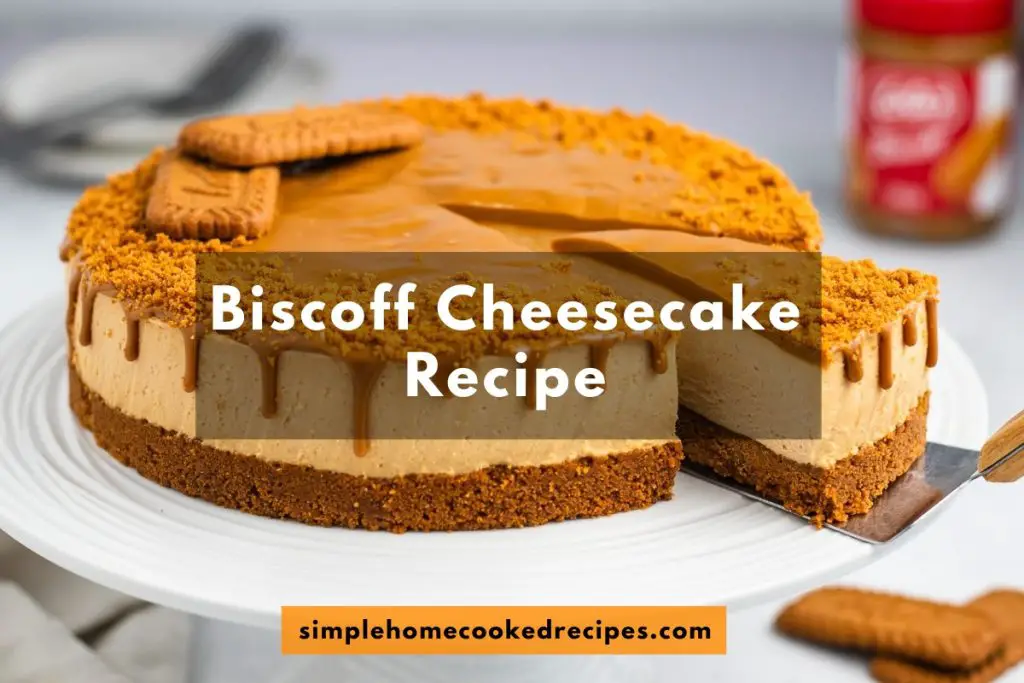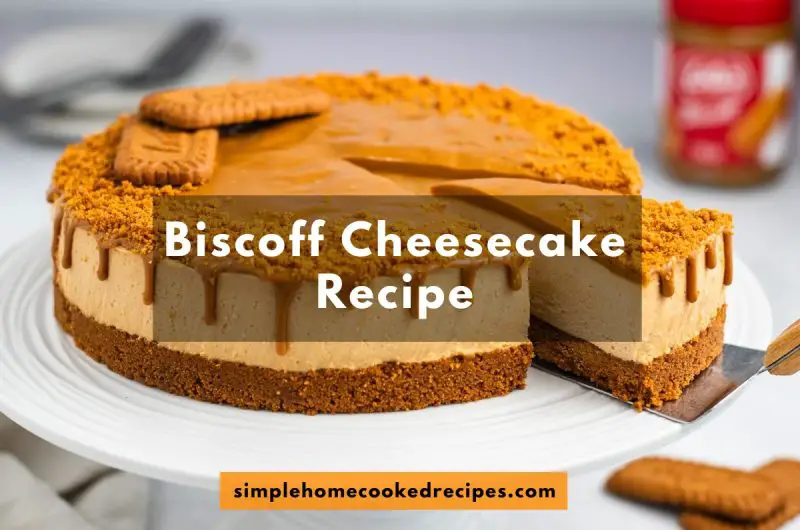
Who doesn’t want an easy to make, yet delicious dessert? Our Biscoff Cheesecake recipe is the perfect solution to all your problems. It can be made instead of a birthday cake, for a special occasion or for a dinner party. However, the best part about this Lotus Biscoff Cheesecake recipe is how easy it is to make.
Below is the easy, no-bake Biscoff Cheesecake recipe, which will delight your taste buds!
Recipe For Biscoff Cheesecake – Everything You Need To Know:
This easy Biscoff Cheesecake recipe can delight up to 12 people. It is as simple as possible, with ingredients that can easily be found. Not only that, but all the ingredients are easily affordable and no baking is required.
Lotus Biscoff biscuits have grown in popularity over the past few years due to their unique taste. These delicate, caramel flavored biscuits originated in Belgium. These biscuits are caramel flavored along with a taste of ginger and nutmeg.
This Lotus Biscoff Cheesecake recipe not only uses Biscoff biscuits and crumbs, but also Lotus Biscoff spread to sweeten it.
Biscoff Cheesecake Ingredients
For the crust
- 300 g Biscoff Biscuits: These biscuits are the main ingredient of this Biscoff cheesecake recipe. These will be crushed into fine crumbs.
- 100 g Unsalted Butter: Unsalted butter is the best for cheesecake, as it will slightly balance the sweetness of the sugar.
For the cheesecake filling
- 450 g Full Fat Cream Cheese: Full fat cream cheese has a richer, creamier texture and it provides stability to the cheesecake filling.
- 75 g Icing Sugar: Using icing sugar, also known as powdered sugar, helps creates a more uniform consistency.
- 250 g Smooth Biscoff Spread: The Biscoff spread adds to the taste and texture of the cheesecake filling.
- 1/2 tsp Vanilla Extract: The Vanilla extract provides an extra depth of taste as well as gives off an inviting aroma.
- 270 ml Double Cream: The double cream adds a richness and creaminess to the cheesecake filling as well as the velvety feeling.
For the topping
- 150 g Smooth Biscoff Spread: Biscoff spread not only adds sweetness to the cheesecake, but also adds to the visual appeal for the cake.
- Biscoff Biscuits and Crumbs: The Biscoff biscuits will be used for decoration and a neat, tidy presentation.

How To Make Biscoff Cheesecake
For the crust
- Put the biscoff biscuits in a food processor and crush them until they are broken down into fine crumbs.
- Transfer the crumbs into a mixing bowl and add the melted butter. Stir the mixture till it resembles wet sand,
- Spread this mixture into a 20 cm cake tin. Use the back of a spoon/spatula to smooth the layer out evenly into a compact shape. Put this mixture in the refrigerator for at least 30 minutes while you prepare the cheesecake filling.
For the cheesecake filling
- Take a large mixing bowl and add the cream cheese, icing sugar, Biscoff spread and vanilla extract and beat it with a electric hand whisk until it is well combined, almost to the consistency of ice cream.
- In a separate bowl, whip the cream until it forms stiff peaks.
- Fold the whipped cream into the other cheesecake filling ingredients till it is combined.
- Layer this cheesecake filling on top of the crust base of the cheesecake. It is easier to do this in two layers to avoid any air bubbles. Smooth the top with a spatula and then bang the cake tin once or twice on the kitchen counter to get rid of any air bubbles.
- Put the cake tin in the refrigerator for at least 4 hours and if possible, overnight.
- After the time has passed, remove the cheesecake from the cake tin by using a sharp, warm knife and running the knife around the edges of the tin, then gently unclipping the side and lifting it away. Use two spatulas to lift the cheesecake from the base of the tin and transfer it to a plate.
For the filling
- Melt the Biscoff spread on low heat or in 10 second bursts in the microwave. Pour the melted Biscoff spread all over the top of the cheesecake.
- For decoration, add some Biscoff biscuits and crumbs on top of the cheesecake.
Also Try: Recipe For Chocolate Tiffin
Tips To Make The Best Biscoff Cheesecake
While making the Biscoff cheesecake, make sure to follow these tips and tricks for the best possible results:
- Make sure you whip the cream as soon as you take it out from the refrigerator, as room temperature cream does not whip as good. Make sure to whip the cream to the extent that it holds its shape, like the texture of ice cream.
- While mixing the cheesecake filling ingredients, make sure not to over-mix them, as it can make the cheesecake break.
- Use a springform tin so that the Biscoff cheesecake can be easily removed when sliced for serving.
- Warm a sharp knife under the hot tap, dry it and then use it to go all around the sides of the cheesecake before removing it.
- Melt the Biscoff spread for the topping very gently so it loosens up. Do not let the spread get too hot.
- Be as creative as possible with the topping of the Biscoff biscuits and crumbs.
Biscoff Cheesecake Recipe FAQs
Why has my cheesecake not set?
Some things that help the cheesecake to set are using full fat cream cheese, whip the cream more and prolonging the cooling time as much as possible.
How to slice the Biscoff Cheesecake?
Make sure the Biscoff Cheesecake is properly set. Also, slicing the cheesecake with a warm knife is recommended.
How long can you store the Biscoff Cheesecake for?
The Biscoff cheesecake can be stored in the fridge for up to 4 or 5 days, covered in an air tight container.
Biscoff Cheesecake Recipe Card
Biscoff Cheesecake Recipe: A Guide To Dessert Heaven
Course: DessertCuisine: AmericanDifficulty: Easy12
servings30
minutes4
hours575
kcal4
hours30
minutesIngredients
- For the crust
300 g Biscoff Biscuits
100 g Unsalted Butter
- For the cheesecake filling
450 g Full Fat Cream Cheese
75 g Icing Sugar
250 g Smooth Biscoff Spread
1/2 tsp Vanilla Extract
270 ml Double Cream
- For the topping
150 g Smooth Biscoff Spread
Biscoff Biscuits and Crumbs
Directions
- For the crust
- Put the biscoff biscuits in a food processor and crush them until they are broken down into fine crumbs.
- Transfer the crumbs into a mixing bowl and add the melted butter. Stir the mixture till it resembles wet sand,
- Spread this mixture into a 20 cm cake tin. Use the back of a spoon/spatula to smooth the layer out evenly into a compact shape. Put this mixture in the refrigerator for at least 30 minutes while you prepare the cheesecake filling.
- For the cheesecake filling
- Take a large mixing bowl and add the cream cheese, icing sugar, Biscoff spread and vanilla extract and beat it with a electric hand whisk until it is well combined, almost to the consistency of ice cream.
- In a separate bowl, whip the cream until it forms stiff peaks.
- Fold the whipped cream into the other cheesecake filling ingredients till it is combined.
- Layer this cheesecake filling on top of the crust base of the cheesecake. It is easier to do this in two layers to avoid any air bubbles. Smooth the top with a spatula and then bang the cake tin once or twice on the kitchen counter to get rid of any air bubbles.
- Put the cake tin in the refrigerator for at least 4 hours and if possible, overnight.
- After the time has passed, remove the cheesecake from the cake tin by using a sharp, warm knife and running the knife around the edges of the tin, then gently unclipping the side and lifting it away. Use two spatulas to lift the cheesecake from the base of the tin and transfer it to a plate.
- For the topping
- Melt the Biscoff spread on low heat or in 10 second bursts in the microwave. Pour the melted Biscoff spread all over the top of the cheesecake.
- For decoration, add some Biscoff biscuits and crumbs on top of the cheesecake.
Recipe Video
Notes
- Be as creative as possible with the topping
- The Biscoff cheesecake can be stored for up to 5 days in the refrigerator.
Nutrition Facts
12 servings per container
- Amount Per ServingCalories575
- % Daily Value *
- Total Fat
41g
64%
- Saturated Fat 20g 100%
- Trans Fat 0g
- Cholesterol 100mg 34%
- Sodium 312mg 13%
- Total Carbohydrate
47g
16%
- Sugars 22g
- Protein 6g 12%
* The % Daily Value tells you how much a nutrient in a serving of food contributes to a daily diet. 2,000 calories a day is used for general nutrition advice.


